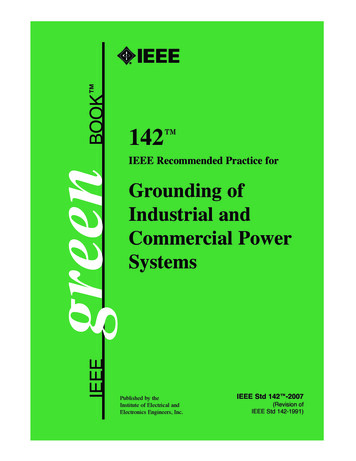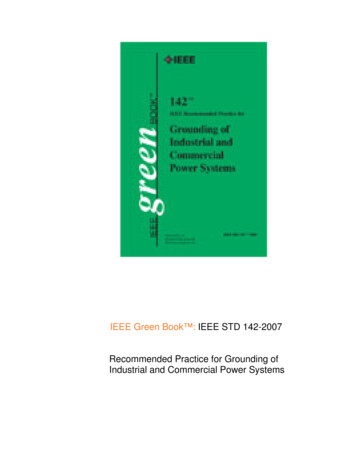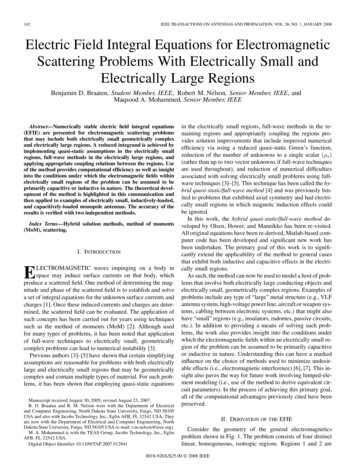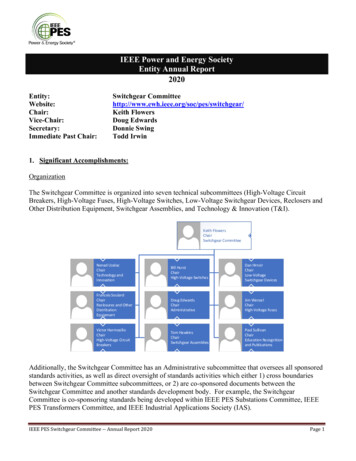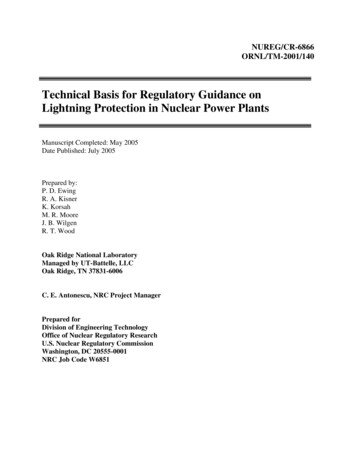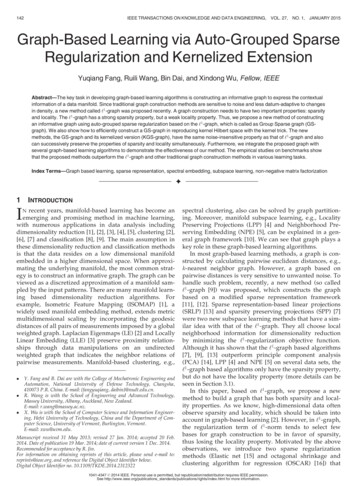
Transcription
142IEEE TRANSACTIONS ON KNOWLEDGE AND DATA ENGINEERING,VOL. 27,NO. 1,JANUARY 2015Graph-Based Learning via Auto-Grouped SparseRegularization and Kernelized ExtensionYuqiang Fang, Ruili Wang, Bin Dai, and Xindong Wu, Fellow, IEEEAbstract—The key task in developing graph-based learning algorithms is constructing an informative graph to express the contextualinformation of a data manifold. Since traditional graph construction methods are sensitive to noise and less datum-adaptive to changesin density, a new method called ‘1 -graph was proposed recently. A graph construction needs to have two important properties: sparsityand locality. The ‘1 -graph has a strong sparsity property, but a weak locality property. Thus, we propose a new method of constructingan informative graph using auto-grouped sparse regularization based on the ‘1 -graph, which is called as Group Sparse graph (GSgraph). We also show how to efficiently construct a GS-graph in reproducing kernel Hilbert space with the kernel trick. The newmethods, the GS-graph and its kernelized version (KGS-graph), have the same noise-insensitive property as that of ‘1 -graph and alsocan successively preserve the properties of sparsity and locality simultaneously. Furthermore, we integrate the proposed graph withseveral graph-based learning algorithms to demonstrate the effectiveness of our method. The empirical studies on benchmarks showthat the proposed methods outperform the ‘1 -graph and other traditional graph construction methods in various learning tasks.Index Terms—Graph based learning, sparse representation, spectral embedding, subspace learning, non-negative matrix factorizationÇ1IINTRODUCTIONrecent years, manifold-based learning has become anemerging and promising method in machine learning,with numerous applications in data analysis includingdimensionality reduction [1], [2], [3], [4], [5], clustering [2],[6], [7] and classification [8], [9]. The main assumption inthese dimensionality reduction and classification methodsis that the data resides on a low dimensional manifoldembedded in a higher dimensional space. When approximating the underlying manifold, the most common strategy is to construct an informative graph. The graph can beviewed as a discretized approximation of a manifold sampled by the input patterns. There are many manifold learning based dimensionality reduction algorithms. Forexample, Isometric Feature Mapping (ISOMAP) [1], awidely used manifold embedding method, extends metricmultidimensional scaling by incorporating the geodesicdistances of all pairs of measurements imposed by a globalweighted graph. Laplacian Eigenmaps (LE) [2] and LocallyLinear Embedding (LLE) [3] preserve proximity relationships through data manipulations on an undirectedweighted graph that indicates the neighbor relations ofpairwise measurements. Manifold-based clustering, e.g., NY. Fang and B. Dai are with the College of Mechatronic Engineering andAutomation, National University of Defense Technology, Changsha,410073 P.R. China. E-mail: {fangyuqiang, daibin}@nudt.edu.cn.R. Wang is with the School of Engineering and Advanced Technology,Massey University, Albany, Auckland, New Zealand.E-mail: r.wang@massey.ac.nz.X. Wu is with the School of Computer Science and Information Engineering, Hefei University of Technology, China and the Department of Computer Science, University of Vermont, Burlington, Vermont.E-mail: xwu@uvm.edu.Manuscript received 31 May 2013; revised 27 Jan. 2014; accepted 20 Feb.2014. Date of publication 19 Mar. 2014; date of current version 1 Dec. 2014.Recommended for acceptance by R. Jin.For information on obtaining reprints of this article, please send e-mail to:reprints@ieee.org, and reference the Digital Object Identifier below.Digital Object Identifier no. 10.1109/TKDE.2014.2312322spectral clustering, also can be solved by graph partitioning. Moreover, manifold subspace learning, e.g., LocalityPreserving Projections (LPP) [4] and Neighborhood Preserving Embedding (NPE) [5], can be explained in a general graph framework [10]. We can see that graph plays akey role in these graph-based learning algorithms.In most graph-based learning methods, a graph is constructed by calculating pairwise euclidean distances, e.g.,k-nearest neighbor graph. However, a graph based onpairwise distances is very sensitive to unwanted noise. Tohandle such problem, recently, a new method (so called‘1 -graph [9]) was proposed, which constructs the graphbased on a modified sparse representation framework[11], [12]. Sparse representation-based linear projections(SRLP) [13] and sparsity preserving projections (SPP) [7]were two new subspace learning methods that have a similar idea with that of the ‘1 -graph. They all choose localneighborhood information for dimensionality reductionby minimizing the ‘1 -regularization objective function.Although it has shown that the ‘1 -graph based algorithms[7], [9], [13] outperform principle component analysis(PCA) [14], LPP [4] and NPE [5] on several data sets, the‘1 -graph based algorithms only have the sparsity property,but do not have the locality property (more details can beseen in Section 3.1).In this paper, based on ‘1 -graph, we propose a newmethod to build a graph that has both sparsity and locality properties. As we know, high-dimensional data oftenobserve sparsity and locality, which should be taken intoaccount in graph-based learning [2]. However, in ‘1 -graph,the regularization term of ‘1 -norm tends to select fewbases for graph construction to be in favor of sparsity,thus losing the locality property. Motivated by the aboveobservations, we introduce two sparse regularizationmethods (Elastic net [15] and octagonal shrinkage andclustering algorithm for regression (OSCAR) [16]) that1041-4347 ß 2014 IEEE. Personal use is permitted, but republication/redistribution requires IEEE permission.See http://www.ieee.org/publications standards/publications/rights/index.html for more information.
FANG ET AL.: GRAPH-BASED LEARNING VIA AUTO-GROUPED SPARSE REGULARIZATION AND KERNELIZED EXTENSIONhave the automatic group effect for the graph construction. Then a novel group sparse graph method (GS-graph)and its kernelized version (KGS-graph) are proposed forseveral graph-based learning algorithms. The proposedgraph has the same noise-insensitive property as that of‘1 -graph, and also has successively preserved the groupand local information in the graph. Our empirical studieson benchmark data sets demonstrate the promising resultsof the proposed method.The rest of this paper is organized as follows. In Section 2,the related work on graph-based learning algorithms isreviewed. In Section 3, the main disadvantage of sparsegraph construction is analyzed and then our newly developed group sparse based graph construction algorithm andits kernelized version are introduced for several graphbased learning algorithms. In Section 4, the experimentalresults and analysis are then presented. Finally, conclusionsand discussions are provided and the further work is alsoindicated at the end of the last section. Note that the preliminary result of this research has been reported in a conference paper in [17]. Compared with the paper [17], wefurther improve our work in the following aspects: (1) Motivated by the success of the kernel trick in capturing the nonlinear similarity of features, we propose the KGS-graphconstruction method in this paper, which extends our original method by an implicit kernel function; (2) We performmore extensive experiments to compare our GS-graph andKGS-graph with related graph construction methods indata clustering and classification tasks; (3) We also showmore comprehensive theoretical analysis for our method,including the algorithm details, computational complexityand the proof of the locality property.Notation. For any vector x , its transpose is denoted by x ,and its ith component is x ½i . The ‘1 -norm of x �PPkxxk1 ¼ i jxx½i j, and its ‘2 -norm is kxxk2 ¼ðxx½i Þ2 . For anyin nmatrix X 2 R , we use s max ðXXÞ to denote the largesteigenvalue of X . Moreover, ð Þþ ¼ maxð0; Þ is the thresholding function and sgnð Þ is the signum function.2RELATED WORK2.1 Graph-Based LearningAlthough the motivations of different manifold and graphbased learning algorithms vary, their objectives are similar,which are to derive a lower-dimensional manifold representation of high-dimensional data, to facilitate related tasks.The central to them is constructing a graph structure thatmodels the contextual information (i.e., geometrical and discriminative structure) of the data manifold.Suppose we have n data points represented as a matrixX ¼ ½xx1 ; x 2 ; . . . ; x n , where xi 2 Rm . With the data points,we can build a graph G ¼ ðV; EÞ, where the vertex set of thegraph is referred as VðGÞ ¼ fxx1 ; x2 ; . . . ; xn g, its edge set toEðGÞ ¼ feij g. The number of vertices of a graph G is its order[18], written as jGj; its number of edges is denoted by kGk. Ifan edge eij connects vertices xi and x j , we denote the relation as i j. The number of neighbors of a nodeP x is calledxÞ, dG ðxxi Þ ¼ i j eij . Furdegree of x and is denoted by dG ðxther, each edge eij can be weighted by wij 0 for pairwisesimilarity measurements.143For the above notation, it is easy to see that edge eij andweight wij are important factors in graph construction. Incommon graph-based learning algorithms, the edges andweights are often specified in the following manners:xi ; x j ÞÞ1 andGlobal graph. For 8i; j, i j, wij ¼ fðdistðxdðxxi Þ ¼ n 1;kNN graph. For 8i, i k, x k belongs to the k-nearestxi ; x k ÞÞ, dðxxi Þ ¼ k;neighbor vertices for x i , wik ¼ fðdistðx" NN graph. For 8i, i j, if distðxxi ; x j Þ ", wij ¼xi Þ is k" ðxxi Þ2;fðdistðxxi ; x j ÞÞ and dðxMoreover, to describe the concept of sparse graph, weinduce the definition of graph density as follow:Definition 1 (Graph Density [19]). For an undirected graph2kGk.G ¼ ðV; EÞ, the graph density of G is jGjðjGj 1ÞFrom the above definitions, one can see that the densityof global graph is 1 and the kNN graph has a low densitykn. Formally, we define a dense graph is a graphn 1 when kwhich has a high graph density, while a graph with a lowgraph density is a sparse graph.The sparse graph plays an important role in graph-basedlearning. From the sparse graph, one can construct a matrixwhose spectral decompositions reveal the low dimensionalstructure of the submanifold [2]. Thus, with an appropriatesparse graph, we can set up a quadratic objective functionderived from the graph for embedding or subspace learningand solved by the eigenvectors of eigen-problem [10]. Also,the sparse graph based function can be incorporated as ageometric regularization in semi-supervised learning, transductive inference [8] or non-negative matrix factorization(NMF) [6].2.2 Learning with ‘1 -GraphSince the above traditional graph construction methods aresensitive to data noise and less datum-adaptive to changesin density, a new construct method (so-called ‘1 -graph) viasparse representation was proposed and harnessed forprevalent graph-based learning tasks [9]. The assumption of‘1 -graph is that each datum can be endogenously sparsereconstructed by similar training data. Sparse reconstructivecoefficients tend to describe the local neighborhood information, which can be obtained by minimizing an ‘1 -optimization problem or Lasso problem in Statistics [11].In Algorithm 1, the identity matrix I is introduced as apart of the dictionary to code the noise, e.g., the corruptedor occluded pixels in an image [12]. That makes ‘1 -graphmore robust to noise than other pairwise graph constructionmanners. In addition, from Equation (1), we can see that theneighbors of x i is automatically determined by solving an‘1 -regularized linear regression problem. Especially, ‘1 -regularization as a convex relaxation of ‘0 -regularization promotes sparsity in the solution ai . Also, this sparse solutiondetermines the set of support samples, which is closest tothe given sample xi . Formally, if we define the support of aai Þ ¼ fj : a i ½j 6¼ 0g, the graphsparse vector ai as suppða1. distðxxi ; xj Þ denotes the euclidean distance or problem-dependentdistance between two vertices; fð Þ is the non-increasing weight funcx2tion, e.g., Gaussian weight function fðxÞ ¼ expð 2s2 Þ or unit weight function fðxÞ 1.xi Þ is used to denote the number of node x which satisfies2. k" ðxdistðxxi ; xj Þ ":
144IEEE TRANSACTIONS ON KNOWLEDGE AND DATA ENGINEERING,Fig. 1. ‘1 -norm regularization encourages sparsity, but it tends to selectfew samples randomly from the entire class. For example, digit ”7” issimilar to digit ”1” in some situations, Lasso may choose a single wrongsample as shown in the left figure. However, group sparse regularizationencourages group sparsity, which tries to represent the test sample witha group of similar samples as shown in the right figure.Pnjsuppðaai Þjidensity of ‘1 -graph is. Since jsuppðaai Þjn,nðn 1Þ1‘ -graph can be defined as a sparse graph. Now, we summarize the ‘1 -graph construction method as follow:ai ½j j when i j‘1 -graph. For 8i, i j, if a i ½j 6¼ 0, wij ¼ jaxi Þ ¼ jsuppðaai Þj.and jaai ½j 1 j when i j, dðx3PROPOSED METHOD3.1 Sparsity versus Group SparsityResearch in manifold or graph-based learning shows that asparse graph characterizing locality relations can conveythe valuable information for classification and clustering[2]. Thus, two of important issues in graph construction aresparsity and locality.The ‘1 -graph just considers the sparse representationduring sparse graph construction. One can choose theweights and edges connecting x i to other vertices by solvingthe Lasso problem, and utilize the recovery coefficients toreveal the latent locally sparsity. In our opinion, the‘1 -graph has the following limitations:(1) ‘1 -norm (Lasso) regularization encourages sparsitywithout any consideration of locality. Indeed, most graphoriented learning algorithms are proposed under the manifold assumption [1], [2], [3], [4], [5], [8]. Also, the graphs inthe learning algorithm are used to approximating theunderlying manifold. Furthermore, the core of the manifoldconcept is locally euclidean, equivalents to the requirementthat each data point x i has a neighborhood subspace Uhomeomorphic to an n-ball in Rn [20]. Ideally, whenVOL. 27,NO. 1,JANUARY 2015Fig. 2. Nonzero sparse coefficients solved by Lasso, Elastic net andOSCAR; Left: Keeping the same number of nonzero coefficients byadjusting regularization parameters; Right: Increasing the number of nonzero coefficients to compare the performances of different regularization.constructing a graph via endogenous sparse representation,we desire the neighborhood subspace U is supported withthe data that are indicated by the nonzero sparse coefficients. That means the support samples are highly correlated with each other to satisfy the property locallyEuclidean. Thus, we desire the nonzero coefficients localityand sparsity not merely sparsity.(2) ‘1 -norm regularization encourages sparsity, but ittends to select only one sample from the entire class [15],[21], as a nearest neighbor selector in the extreme case.Thus, when some samples are correlated from differentclasses (e.g., digit ”7” is similar to digit ”1” in some situations, but they belong to different classes), Lasso maychoose a single wrong sample to represent the test sampleas shown in Fig. 1. Thus, ‘1 -graph is too sparse to keep thehigh discriminating power for graph-based learning.(3) Without a group constraint, the nonzero sparse coefficients by ‘1 -norm regularization tend to unstable and theresult is difficult to be interpreted. For example, in Fig. 2,when we adjust the regularization parameters to increasethe nonzero sparse coefficients (i.e., the degree of a node),some small weight coefficients solved by Lasso will be randomly distributed3. Thus, we need some new group sparsity regularizers, as discussed in next section, which cankeep coefficients group and clustered sparse.In summary, ‘1 -norm regularization for sparse graphconstruction has a major limitation, which can only satisfythe sparsity constraint, but cannot satisfy the locality constraint simultaneously. To overcome this limitation, weintroduce and extend two alternate regularization methodsthat can enforce automatically group sparsity for the graphconstruction.3.2 GS-Graph ConstructionThe problem of group sparsity is studied in [22], [23].They assume that the sparse coefficients in the samegroup tend to be either zero or nonzero simultaneously.3. In this example, we built a dictionary with 400 noised imagesfrom the teapot data set (details described in Section 4.1), and then oneselected image is reconstructed by different methods, all coefficientsare normalized and shown in the figure.
FANG ET AL.: GRAPH-BASED LEARNING VIA AUTO-GROUPED SPARSE REGULARIZATION AND KERNELIZED EXTENSIONFig. 3. Graphical representation of the constraint regions of Lasso, Elastic net, and OSCAR; Especially, OSCAR has an octagonal constraintregion, which can achieve a grouping property [16]. The Elastic net canbe adjusted between ‘1 - and ‘2 -regularization with different tuningparameters (dashed lines). Thus, the Elastic net could induce a groupingproperty with appropriate tuning.145where V g 1 ; 2 ð Þ denotes the auto-grouped sparse regularization, i.e., Elastic net or OSCAR. The above optimization problem is based on the standard least squares criterion and an‘1 -regularization term on noise term e i . Typically, if we set 1 ¼ and 2 ¼ 0, Equation (4) will degenerate into Equation(1) used in Algorithm 1. However, since there is no closedform solutions for this optimization problem, we proposed anefficient alternating procedure to obtain the optimal solutionof Equation (4) with Accelerated Proximal Gradient (APG)method [24] and summarized the details in Algorithm 2.However, in these papers, the label information of groupsis required to be known in advance. In other words, theybelong to supervised learning. However, in our method,we focus on unsupervised learning, the same as ‘1 -graph[9]. When constructing a sparse graph in an unsupervisedscenario, the label information of groups can be unknownin the data set but the sparsity and group clustering tendare known.In this paper, two sparse regularization methods with anauto-grouped effect are introduced and extended for graphconstruction, Elastic net [15] and OSCAR [16].Elastic net. The Elastic net regularizer is a combinationof the ‘1 - and ‘2 -norms. The ‘1 -penalty promotes sparsity,while ‘2 -penalty encourages the grouping effect [15]. Whenapplying this regularization to constructing a sparse graph,we can modify Equation (1) as follows: 21 2 2ai k1 þ ai 2 ;min x i X i a i 2 þ 1 kaai 22(2)where 1 and 2 are regularization parameters.OSCAR. Octagonal shrinkage and clustering algorithmfor regression [16] is a novel sparse model that constructs aregularizer with a weighted combination of ‘1 -norm and apairwise ‘1 -norm. OSCAR encourages both sparsity andequality of coefficients for correlated samples. Thus, groupsparsity can be automatically discovered without priorknowledge. Utilizing this regularizer, Equation (1) can alsobe modified as the following optimization problem:X 21 ai k1 þ 2maxfjaai ½j j; jaai ½k jg;min x i X i a i 2 þ 1 kaai 2j k(3)where 1 and 2 are regularization parameters. In Fig. 3, wecan see OSCAR uses a new penalty region that is octagonalin shape, which requires no initial information regardingthe grouping structure.Moreover, the real data are usually contaminated withsparse outlying entries or noise, thus we should extend theabove problems to the noise case. Unlike the ‘1 -graph introduced an identity matrix as a part of the dictionary to codethe noise, we extend the auto-grouped sparse regularizedoptimization problem to a robust version as following: 21 ai Þ þ keei k1 ;min x i X i ai ei 2 þ V g 1 ; 2 ðaa i ;eei 2(4)In the proposed Algorithm 2, we minimize the expression in Equation (4) alternately. First, we fix ei and aim tofind the best group sparse coefficient ai . In this stage (i.e.,Steps 5-15), we use APG to solve the problem efficiently,which has the convergence rate Oðk 2 Þ [24]. Meanwhile, byPropositions 1 and 2, the proximal step (i.e., Step 10) can besolved efficiently. Similarly, the second stage (i.e., Steps 1720) fixes a i as known and seeks an update of ei with ashrinkage operator. Finally, the iterative operation is terminated when the number of iterations is reached.Time complexity. It is easy to see that computing h k inStep 8 will take OðmnÞ time. For Steps 5-15, an -approximate solution of b k can be obtained by APG in Oðp1ffi Þiterations [24]. In each iteration, Step 10 takes OðnÞ forElastic net and Oðn logðnÞÞ for OSCAR [25]. For Steps 1720, computing eti only takes OðmÞ time. Hence, assumingthe max iteration is t ¼ T , Algorithm 2 takes a total ofOðT ðp1ffi ðm þ 1Þn þ mÞÞ time with Elastic net regularizer.
146IEEE TRANSACTIONS ON KNOWLEDGE AND DATA ENGINEERING,When we use the OSCAR regularizer instead, the totalcomplexity is OðT ðp1ffi ðm þ log nÞn þ mÞÞ.bÞ ¼ 1 kbbk1 þ 22 kbbk22 , then theProposition 1. When Vg 1 ; 2 ðbsolution of the proximal step (Step 10 in Algorithm 2) isb ½i ¼1ðjhhk ½i 1 jÞþ sgnðhhk ½i Þ; i ¼ f1; 2; . . . ; n 1g:1 þ 2(5)Proposition 2. Assuming that the indices i 2 f1; 2; . . . ; n 1ghave been permuted such thatjhhk ½1 jjhhk ½2 j; . . . ;jhhk ½n 1 j;(6)PbÞ ¼ 1 kbbk1 þ 2 j k maxfjbb½j j; jbb½k jg,thus if V g 1 ; 2 ðbthen for each group Gs:t ¼ fi 2 Z : s i tg, the solution ofthe proximal step (Step 10 in Algorithm 2) is4 X 1 1 þ 2 ðn i 1Þk; (7)z ½s : t ¼h ½i t s þ 1 i2GLs:tandb ½i ¼ ðzz½i Þþ sgnðhhk ½i Þ; i 2 G s:t :(8)The result of Proposition 1 is well-known [15]. Also, weomit the proof of Proposition 2 which can be obtained fromTheorem 1 in [25].With these two auto-grouped regularization terms, wecan discover the hidden data groups automatically and estimate the reconstruction sparse coefficient on a group-specific dictionary. Moreover, the learned data groups areconsist of a small number of correlated samples. This meansthat the locality and sparsity properties can be preserved atthe same time. Formally, we can define a set Li to indicatethe nonzero regression coefficients of x i , which are solvedby the auto-grouped sparse representation. Indeed, Li ¼ðaai Þ ¼ fj : a i ½j 6¼ 0g but further emphasizes the datum indicated by Li belongs to a neighborhood subspace and correlates with each other.After inducing an alternate regularizer for promotinggroup sparsity, the construction process is formally statedin Algorithm 3.Therefore, GS-graph in Algorithm 3 inherits the robustness and adaption of ‘1 -graph, also achieves automaticgroup sparsity that is the lack of ‘1 -graph. Conveniently, weterm our two GS-graph as ‘1 ‘2 -graph and ‘1 ‘1 -graph,4. Note that the element of z in each group G has a common value,and the groups can be generated by a series of merge operations withcomplexity Oðn log nÞ. More details of the group merge algorithm canbe found in Algorithm 2 of [25].VOL. 27,NO. 1,JANUARY 2015respectively. Both construction methods can be summarizedas follow:‘1 ‘2 -graph (‘1 ‘1 -graph). For 8i, i j, if ai ½j 6¼ 0, wij ¼ai ½j 1 j when i j, dðxxi Þ ¼ jLi j.jaai ½j j when i j and ja3.3 Kernelized ExtensionThe kernel trick is firstly introduced in support vectormachine (SVM) to deal with classification problems thatare not linearly separable in the origin feature space [26].With the kernel, one can map the feature in the originalspace implicitly to a high or even infinite dimensionalkernel feature space [27], [28]. A nonlinear problem canthen be transferred into a liner problem in the kernelspace since the nonlinear similarity of the original featurecan be captured with the kernel. Thus, many manifoldbased learning algorithms have been generalized to theirkernelized versions, e.g., Kernel PCA [29], Kernel Discriminant Analysis [30], Kernel Locality Preserving Projections [4], etc. Recently, the kernel trick was introducedinto sparse representation to building sparse models inthe kernel feature space. For example, Kernel SparseRepresentation (KSR) was proposed for improving theclassification accuracy for object recognition [31]; A newclassifier named Kernel Sparse Representation-basedClassifier (KSRC) [32] was proposed as a nonlinear extension of Sparse Representation-based Classifier (SRC) [12];A kernelized dictionary learning method was presentedfor learning the sparse and overcomplete signal representation in the kernel feature space [33].In this section, we also extend our GS-graph to a kernelized version (named KGS-graph). In KGS-graph, the kernelsparse representation is utilized to derive the neighbor sample of a datum and its corresponding ingoing edge weights.Especially, we assume that the euclidean space Rm ismapped to a high or even infinite dimensional Hilbert spaceH through a nonlinear mapping function c : Rm ! H. ThisHilbert space is often known as a reproducing kernel Hilbert space (RKHS) corresponding to a Mercer kernel kð ; Þ[26]. Formally, a Mercer kernel kð ; Þ can be considered asan inner product h ; iH in the kernel feature space H. Therefore, given two samples x; z 2 Rm , we have kðxx; z Þ ¼hccðxxÞ; cðzzÞiH . Some commonly used kernels include thepolynomial kernels kðxx; z Þ ¼2 ðhxx; zi þ cÞp and the Gaussiankxx zzk2kernels kðxx; zÞ ¼ exp c , where c and p are theparameters.For the data points X ¼ ½xx1 ; x 2 ; . . . ; x n 2 Rm n , we definetheir images in the kernel feature space with CðXXÞ ¼x2 Þ; . . . ; cðxxn Þ 2 RK n , where K denotes the½ccðxx1 Þ; cðxdimensionality of the kernel feature space H. Usually, thedimensionality K is very large or infinite, thus it is necessary to construct a transformation matrix in H to project theimages CðXXÞ form H into a reduced subspace. Followingthe notion in [32], we define the transformation matrix withT ¼ ½tt1 ; t 2 ; . . . ; td 2 RK d and each column of tj is a linearcombination of images in H:tj ¼nXi¼1g j ½i ccðxxi Þ ¼ g XÞ:j CðX(9)
FANG ET AL.: GRAPH-BASED LEARNING VIA AUTO-GROUPED SPARSE REGULARIZATION AND KERNELIZED EXTENSIONLet G ¼ ½gg 1 ; g 2 ; . . . ; g d 2 Rn d , then we haveT ¼ CðXXÞGG:147TABLE 1The Time Complexity of the Proposed Methods(10)The weight matrix G can be set by a random scheme [32].Recalling Algorithm 3, group sparse coefficients areused to estimate the affinity matrix W for GS-graph construction. In Equation (4), the data x i is reconstructed bythe training data set X i in the origin feature space. Similarly, we can run the reconstruction in the kernel featurespace H instead, 21 X i Þaai e i 2 þ Vg 1 ; 2 ðaai Þ þ keei k1 ;min cðxxi Þ CðXa i ;eei 2(11)CðXXÞ n cðxxi Þ 2 RK ðn 1Þ . Moreover, intewhere CðXX i Þ ¼ ½Cgrating the transform matrix T into Equation (11), Equation(11) can be modified as 2ai Þ þ keei k1 ;min G kð ; x i Þ G K i a i ei 2 þ V g 1 ; 2 ðaa i ;eei(12)x2 ; xÞ; . . . ; kðxxn ; x Þ , and K is thewhere k ð ; x Þ ¼ ½kðxx1 ; x Þ; kðxxi ; x j Þ, so K i ¼ ½KKnkGram matrix with K i;j ¼ kðxð ; x i Þ 2 Rn ðn 1Þ . Let xi ¼ G k ð ; x i Þ and X i ¼ G K i , theoptimization of Equation (12) is equivalent to solving theproblem in Equation (4), which can be solved by Algorithm 2.So far, we have presented an effective sparse modelwith auto-grouped sparse regularization in the kernel feature space H. Based on the kernelized sparse model, ourGS-graph can be generalized to a kernelized version withAlgorithm 4. Compared with Algorithm 3, the new proposed kernelized method emphasizes the endogenoussparse reconstruction (i.e., Step 3 in Algorithm 3) in thekernel space. While, the computation of Algorithm 4 willbe more efficient when we set a low projection dimensiond, i.e., d m. For convenience, we summarize the timecomplexities of Algorithms 3 and 4 in Table 1.of a i are set to be the neighbours of x i and a i ½j denotethe contribution of the jth point to the representation ofxi . Solving a i for each data point, we can forms a neighbourhood graph GX on X .The sparsity constraint can make the graph GX tends to asparse graph, i.e. each node xi in GX has a small degreedG ðxi Þ. A small degree ensures that no connections betweendata from different classes and makes the affinity matrix ofGX to be block diagonal [34].Beyond the sparsity property, we also need the elementsin the neighbours of a node xi are corrected or local grouping. To achieve the locality property, it is expected that thesparse representation ai satisfy the following assumption:for 8j; k 2 f1; 2; . . . ; n 1g, if xj ! x k , then ai ½j ! ai ½k .Typically, the ‘1 -norm regularized sparse representationdoes not have the local grouping property, which has beenexplicated theoretically in [35]. However, from the following Propositions 3 and 4, we can show that the solutionsof Equations (4) and (11) in our method have the localgrouping property theoretically. Then, this proves that theproposed GS-graph and KGS-graph can simultaneouslyachieve both locality and sparsity in graph construction.Proposition 3. Given standardized data matrix X 2 Rm n , anormalized kernel kð ; Þ and parameters ð 1 ; 2 ; Þ. For eachdata x i , let a i be the optimal solution of Equations (4) or (11)ai Þ ¼ 1 kaai k1 þ 22 kaai k22 . Then, if x j ! x k ,with V g 1 ; 2 ðaa i ½j ! a i ½k .Proposition 4. Given standardized data matrix X 2 Rm n , anormalized kernel kð ; Þ and parameters ð 1 ; 2 ; Þ. For eachdata x i , let a i be the optimal solutionP of Equation (4) or (11)bÞ ¼ 1 kbbk1 þ 2 j k maxfjbb½j j; jbb½k jg.withV g 1 ; 2 ðbThen, if xj ! x k , a i ½j ! ai ½k .The proof of Propositions 3 and 4 can be found in the supplemental material, which can be found on the ComputerSociety Digital Library at http://doi.ieeec
reprints@ieee.org, and reference the Digital Object Identifier below. Digital Object Identifier no. 10.1109/TKDE.2014.2312322 142 IEEE TRANSACTIONS ON KNO


